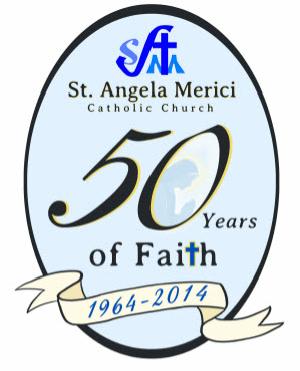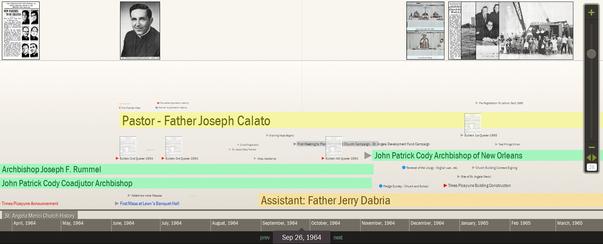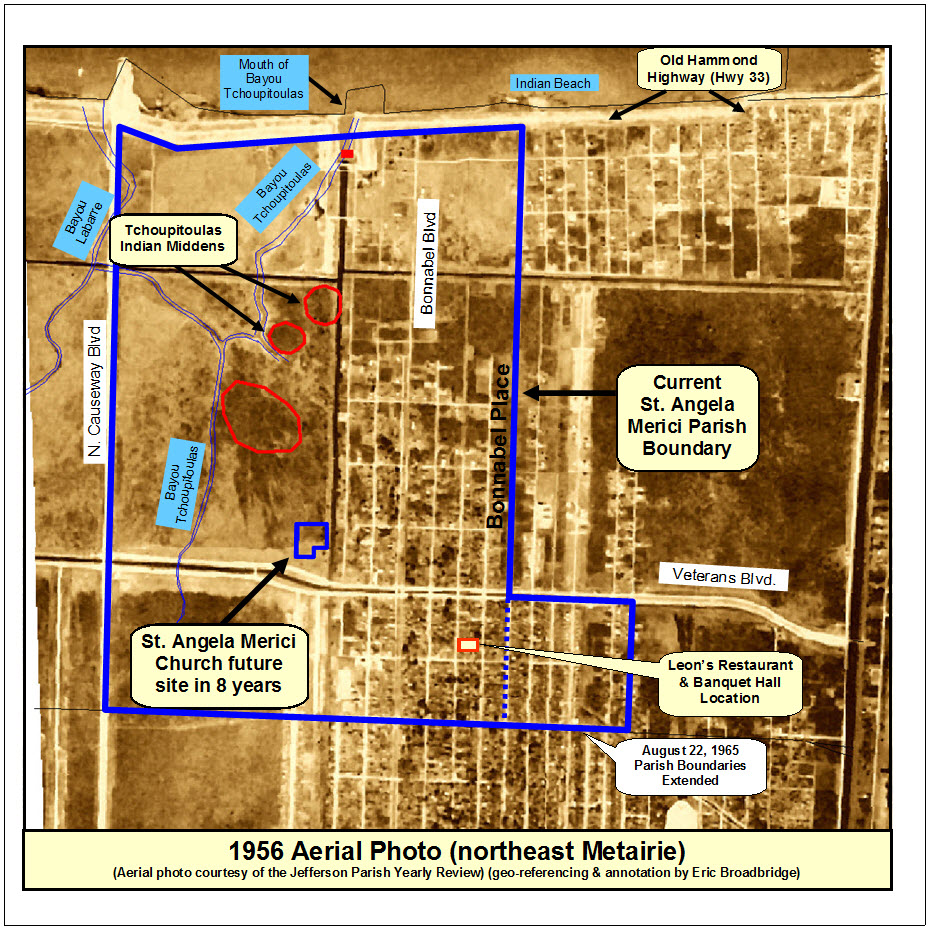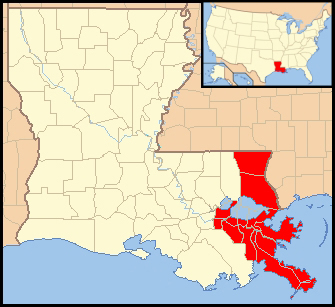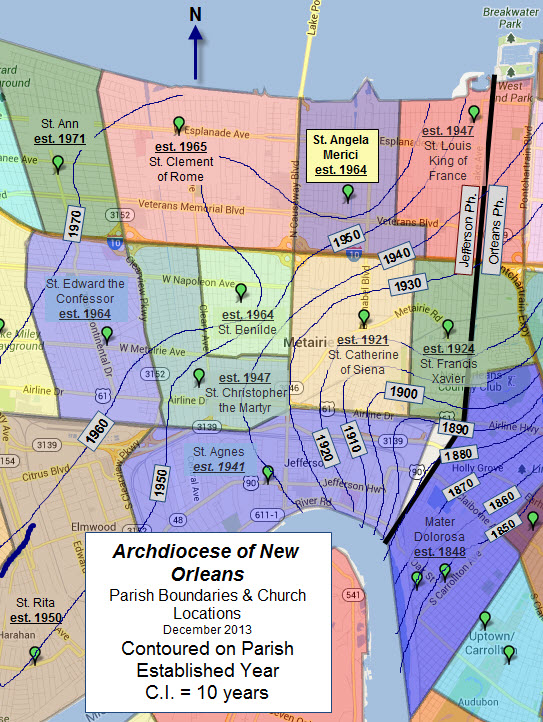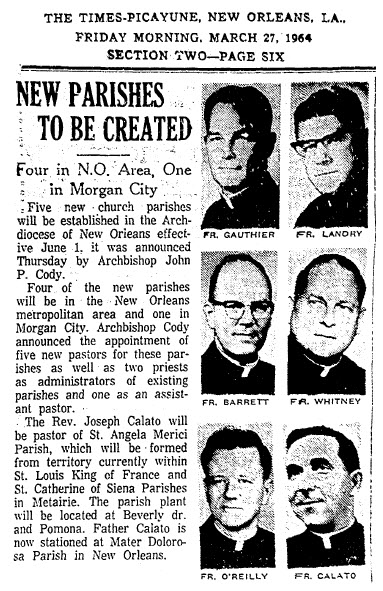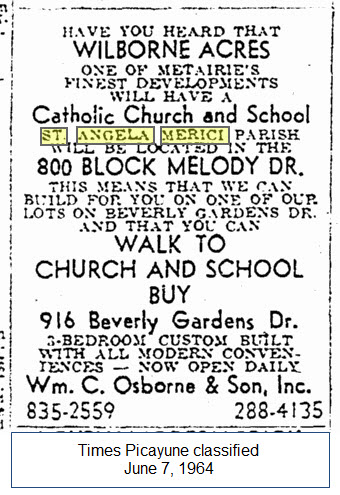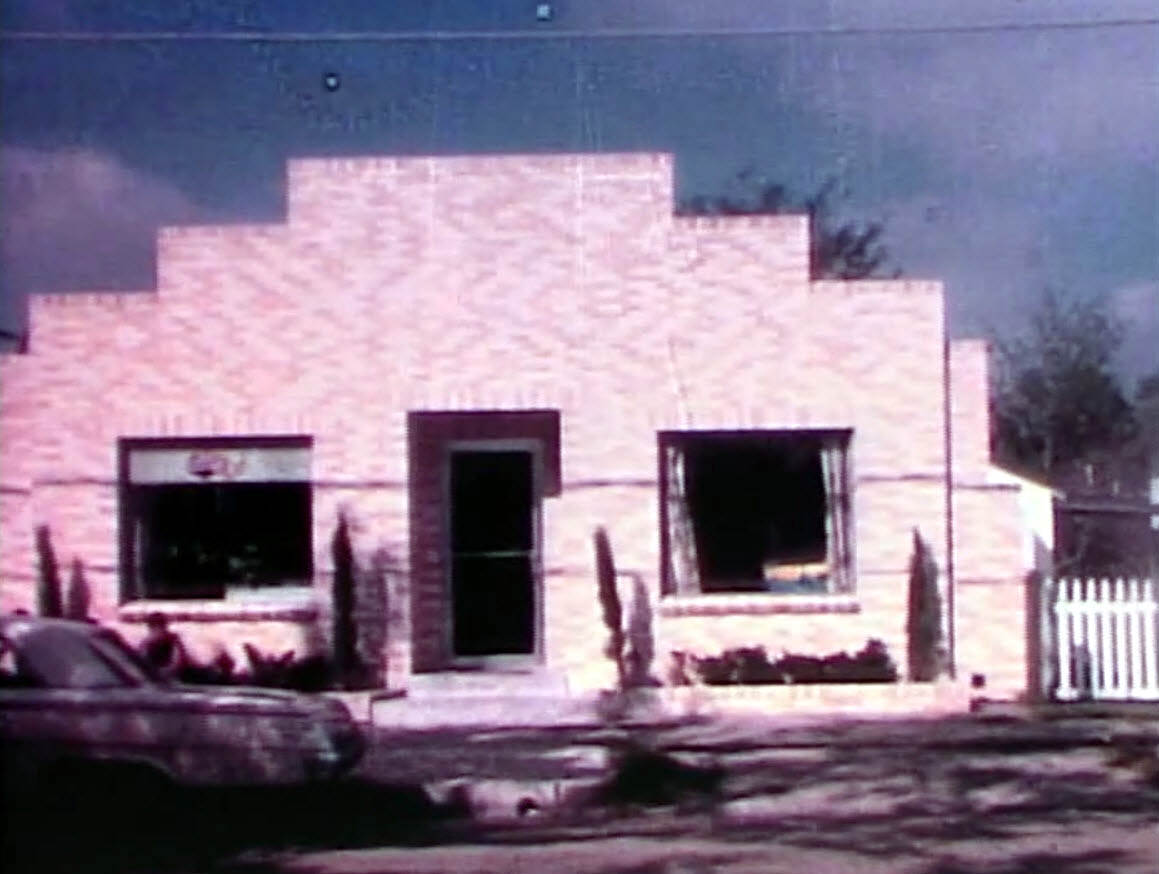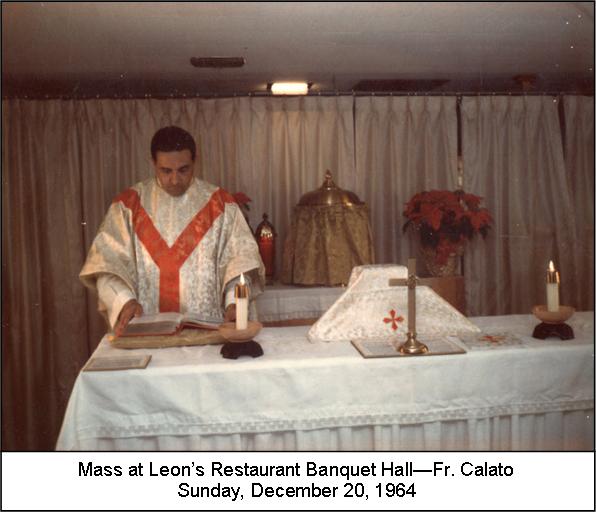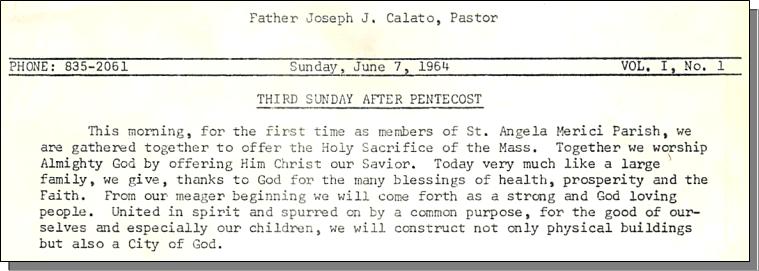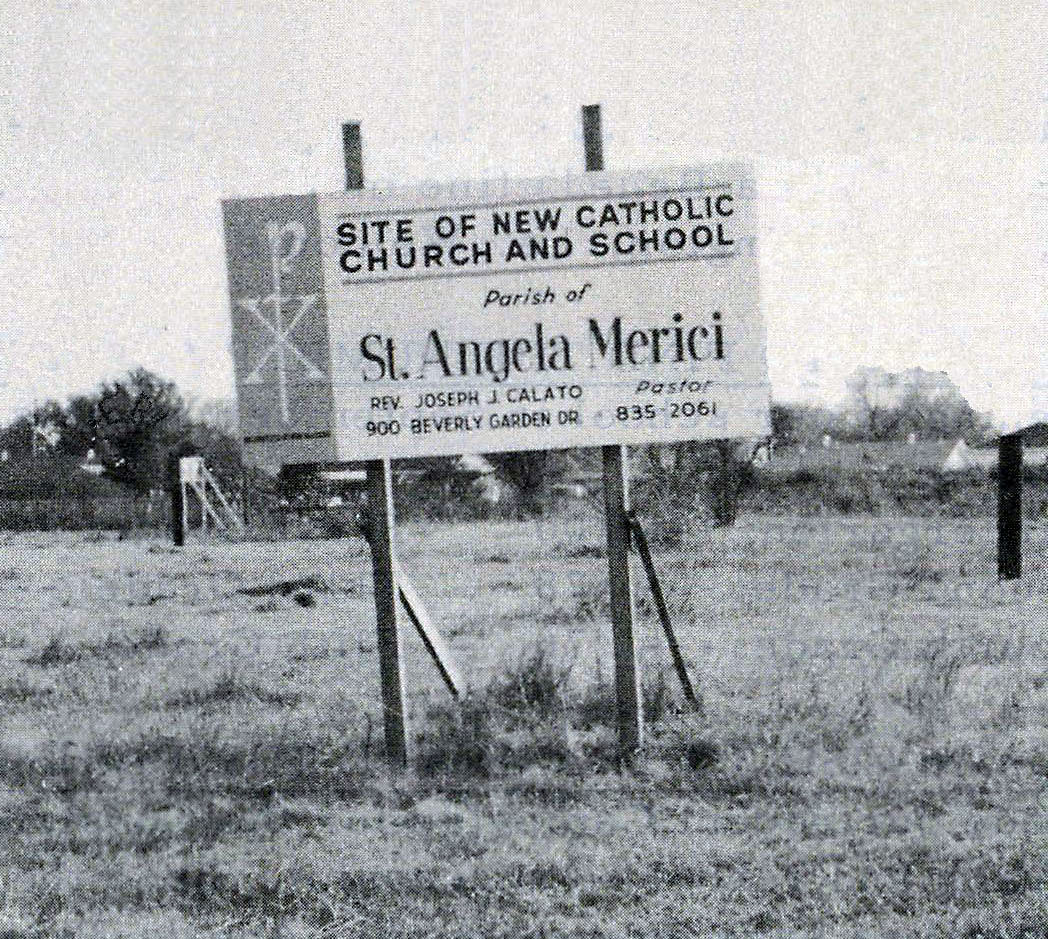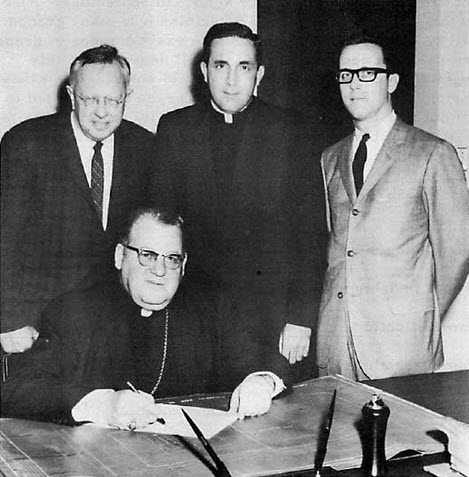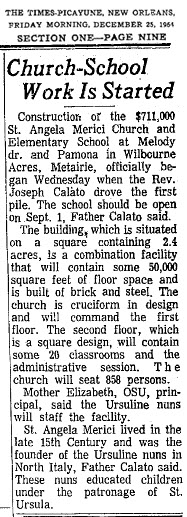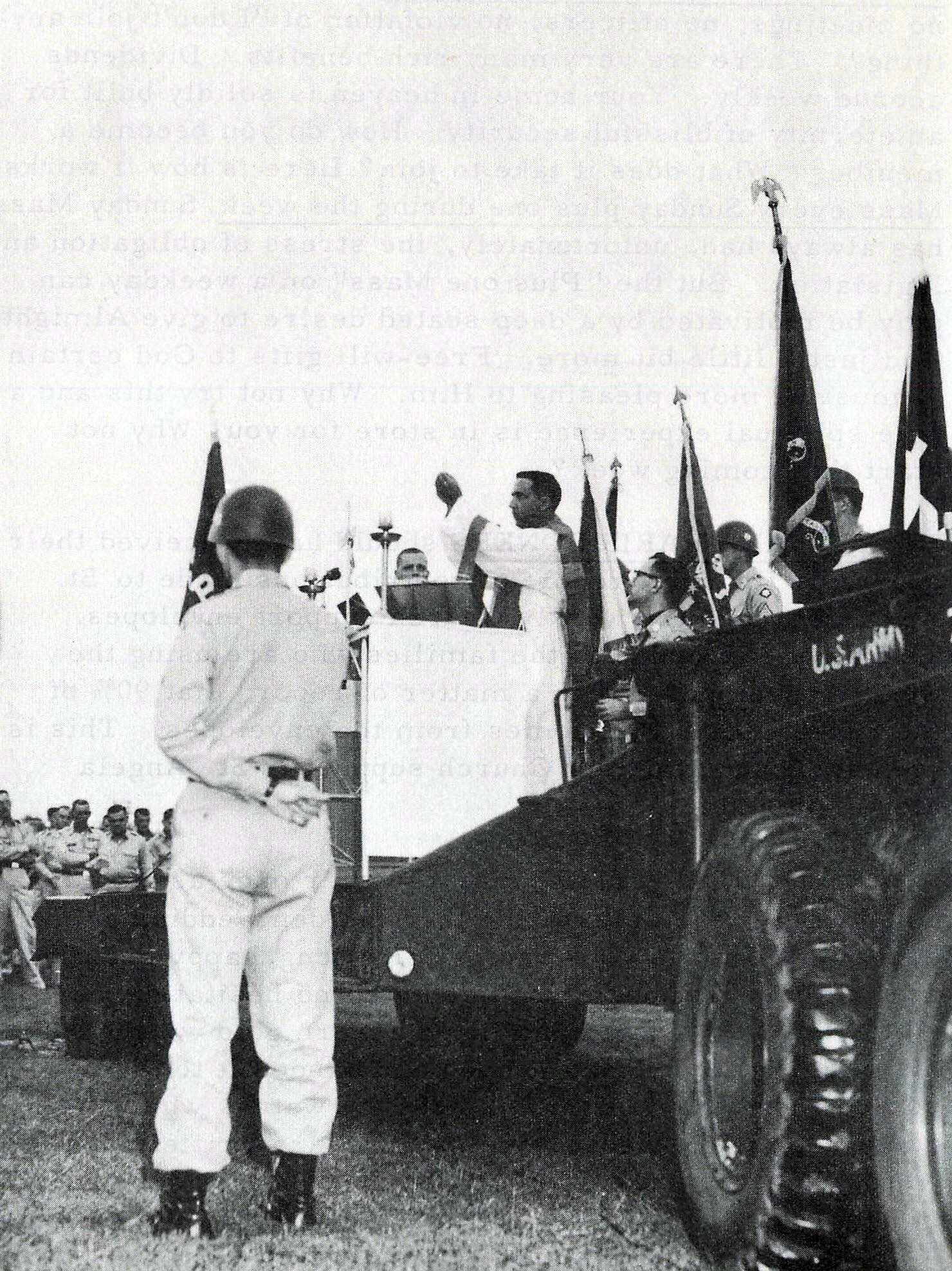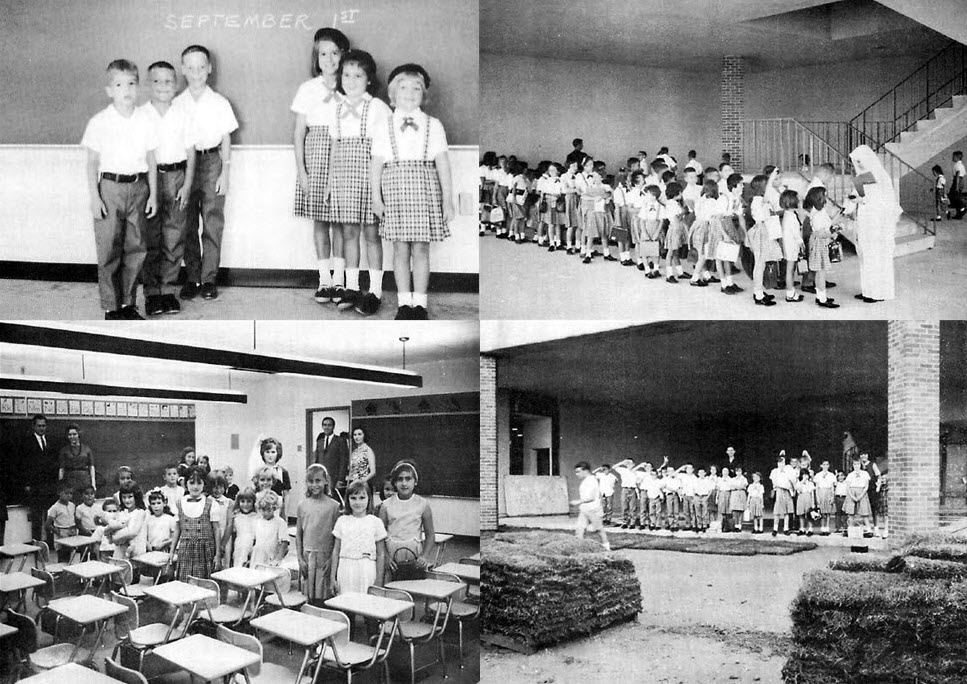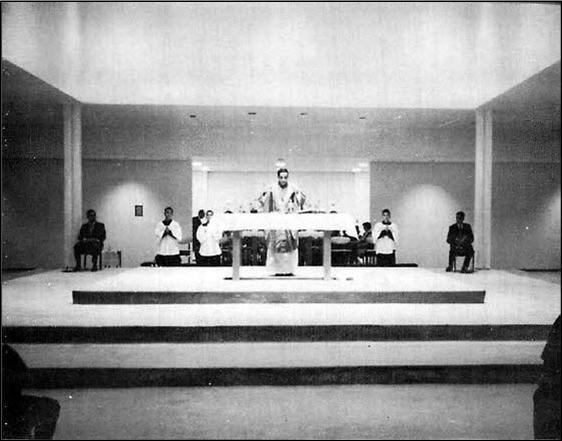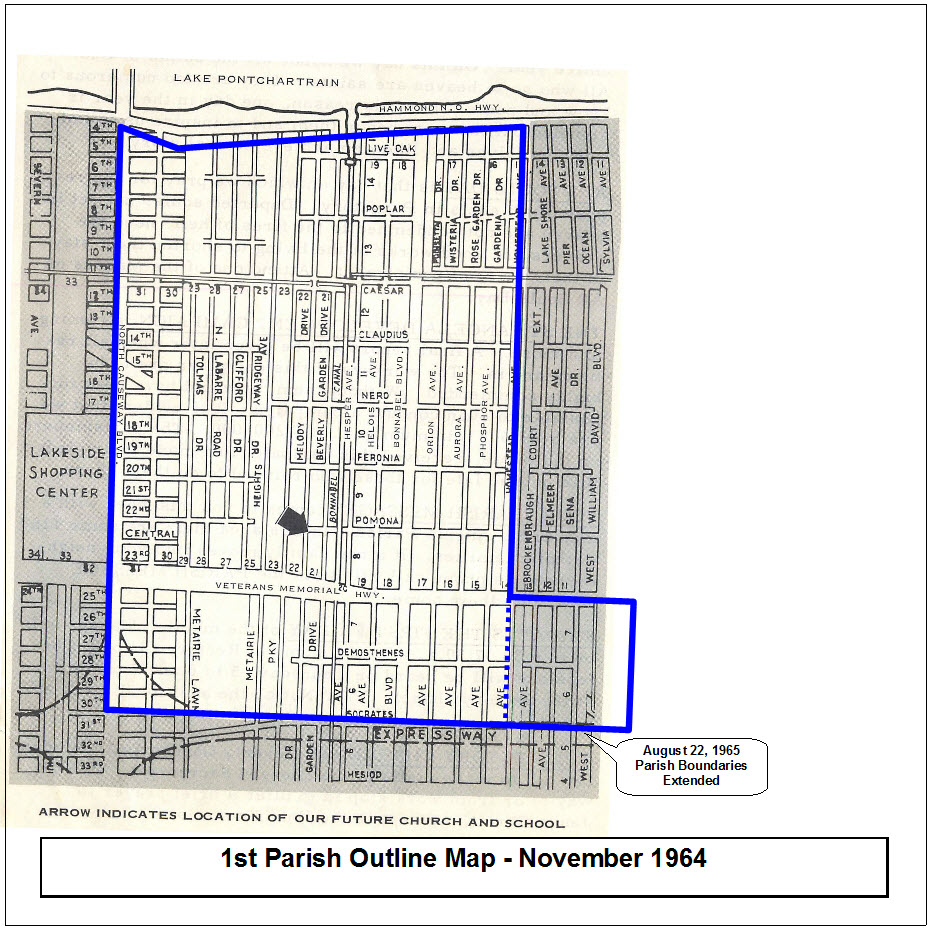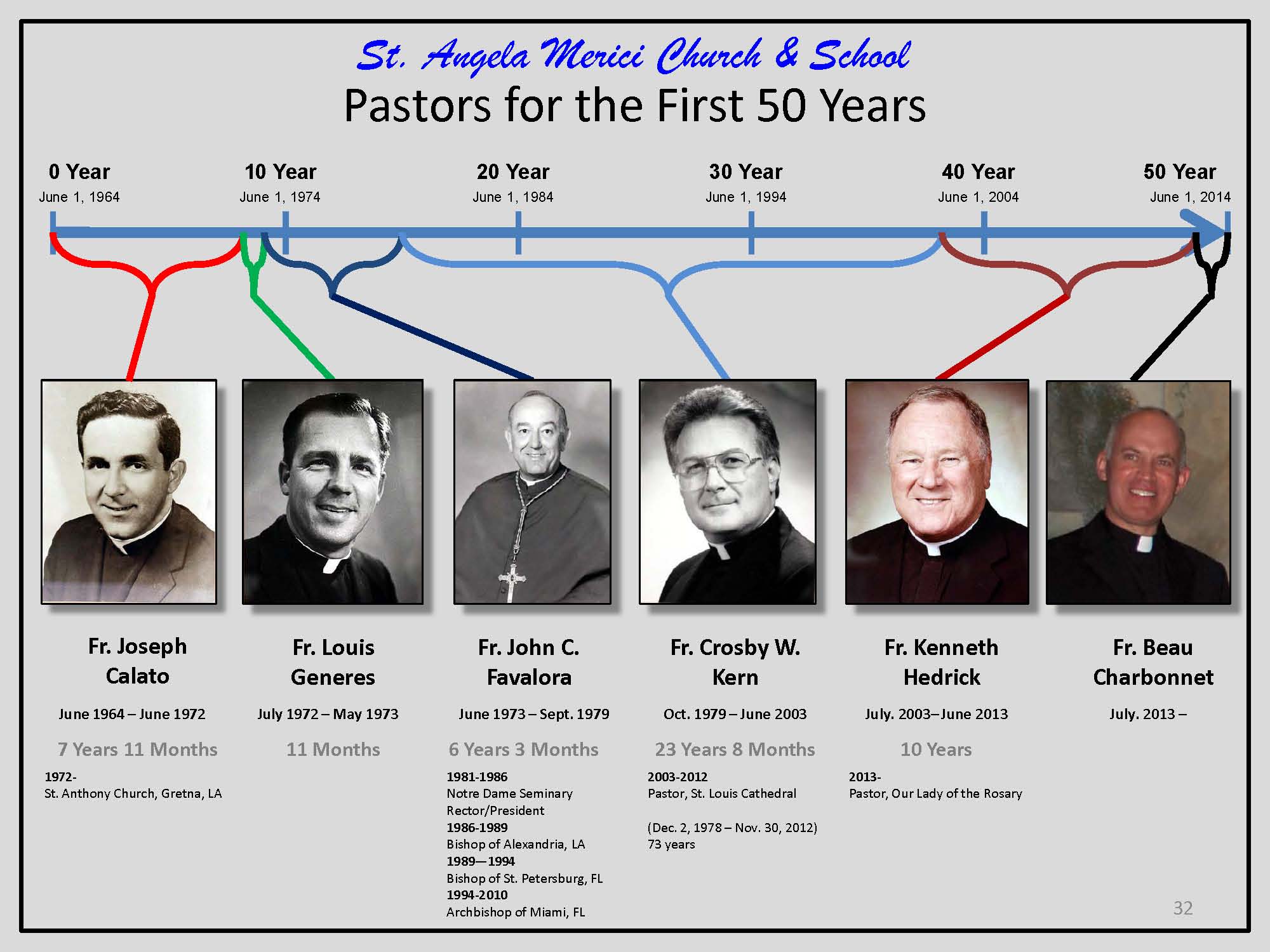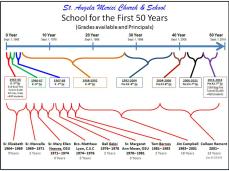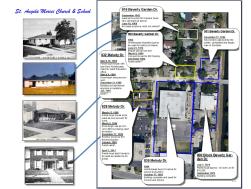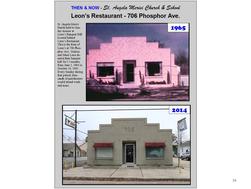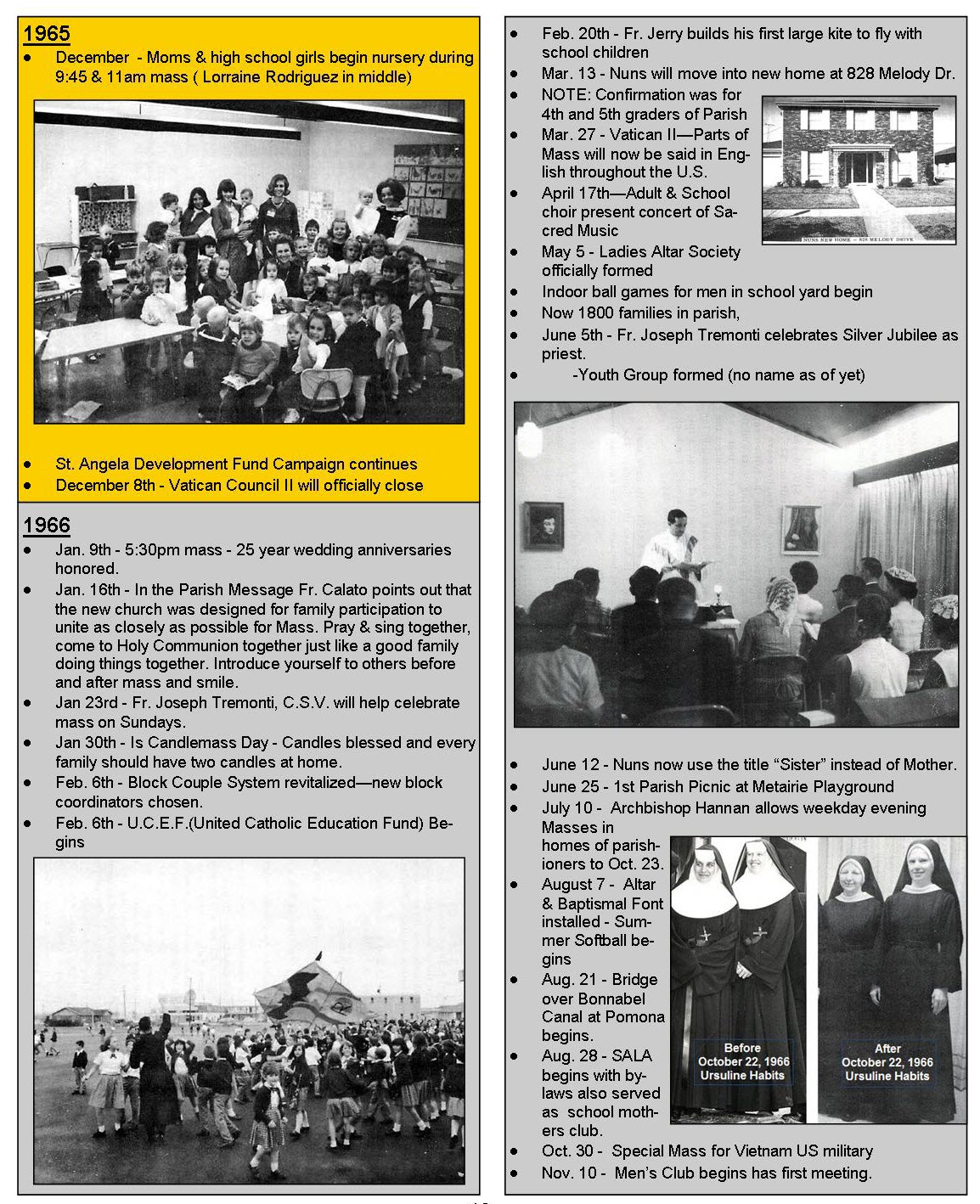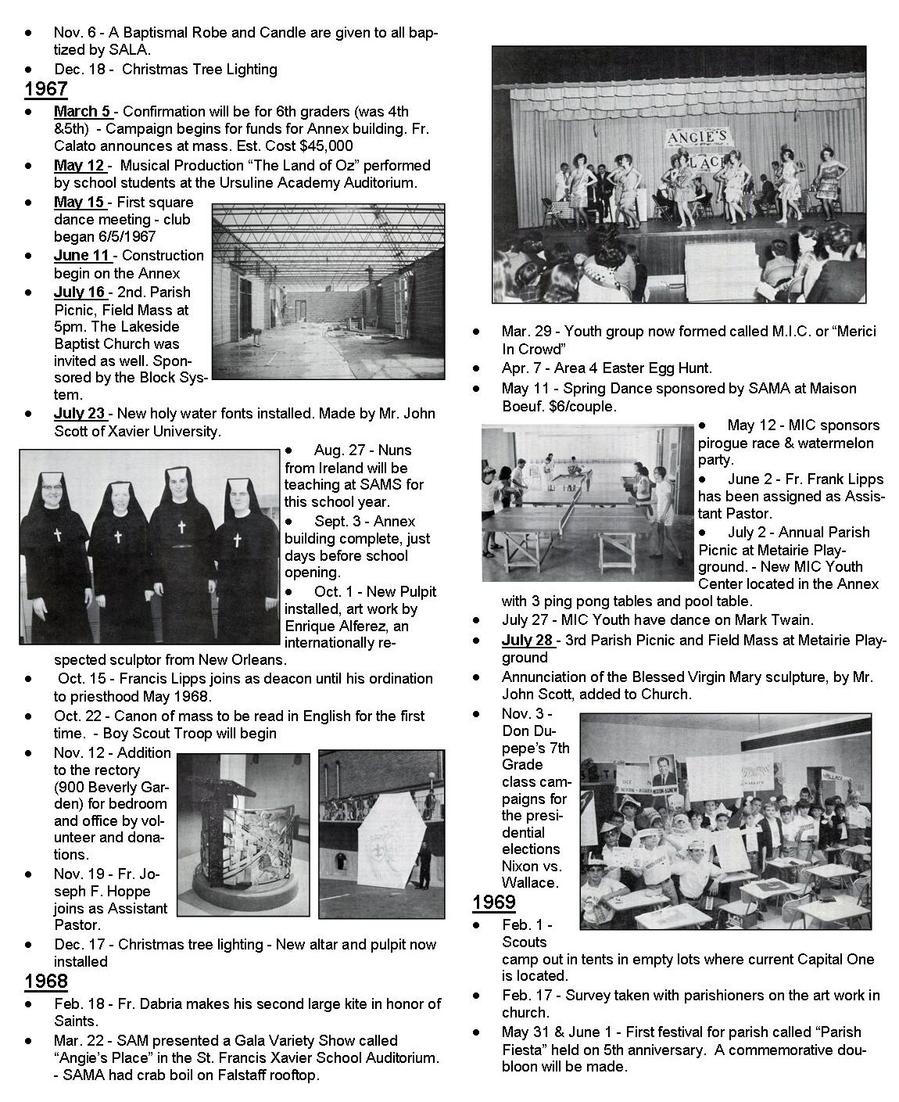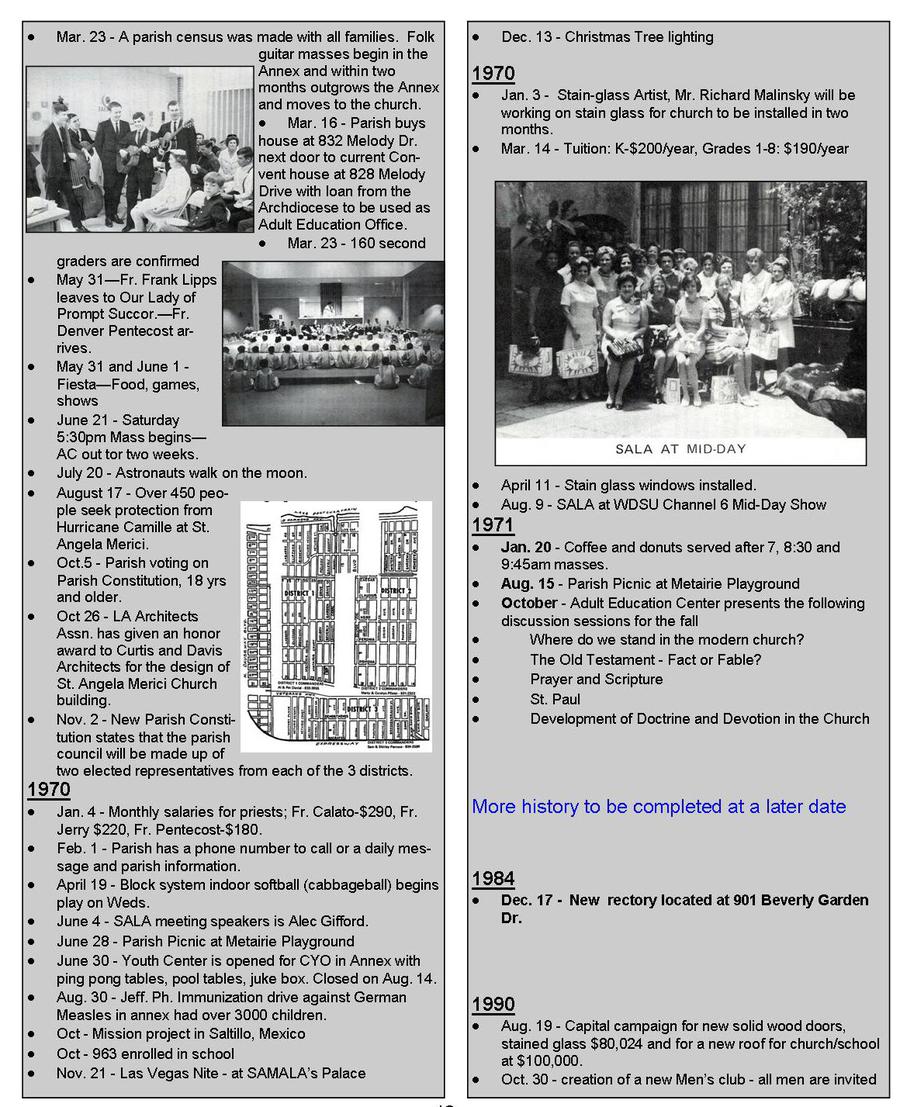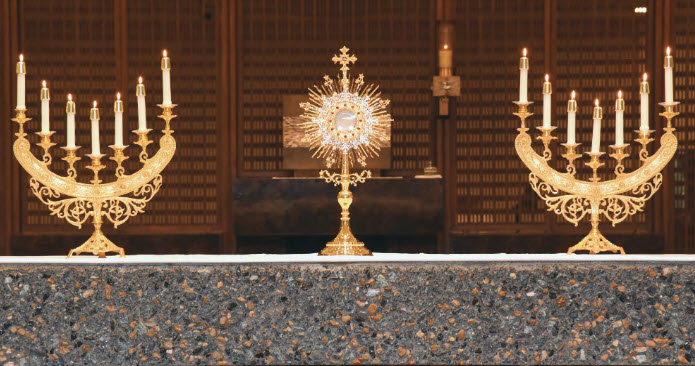 | ||||
CHURCH HISTORY
St. Angela Merici Catholic Church
Administration Office 504.835.0324
Office of Religious Education 504.835.0324
School 504.835.8491
50 YEARS
June 7, 1964 - June 7, 2014
INTRODUCTION
This history is the result of using resources from many places as follows:
- The main source of information was the church bulletin called the “Parish Message”. These bulletins are available from the first week, June 7, 1964 to present. All hard copies of the bulletin have been scanned into PDF format and added to the current digital bulletins to form one collection of all bulletins. This collection was completed in January 2013 and is available in PDF format by quarter-year on the St. Angela Merici Church website and is updated weekly.
- The Parish Message bulletins were one page-two side prints from June 1965 to April 1985. Photos were often included in these original bulletins. Beginning May 1985 the Parish Message lost its name and moved to a larger format that did not have photos.
- Information and photos from past anniversaries, 10th and 25th.
- Msgr. Henry Bezou’s Homily for the 10th Anniversary mass.
- Times Picayune Archive online
- Information gathered from founding families, St. Catherine of Siena & St. Louis King of France websites.
“About St. Angela”
From “St. Angela Merici Parish Message” May 30, 1965
Fr. Calato’s 1st. Anniversary message
On this day, Parish of St. Angela Merici celebrates First Anniversary. We are one year old! During this first year our young Parish witnessed many changes. For many it was somewhat of a new concept. From the very start, the spirit of cooperation and loyal dedication were personified in the majority of parishioners. The first expression of generosity was found in the Marion Leon family in gratuitously offering a reception hall for the Sunday Masses. In a very short time, very many of the parishioners rallied behind the new parish. Enthusiastic zeal, a willingness to sacrifice and to volunteer and work steadily and with momentum began to express themselves in many parishioners who were now determined to solidly establish in their midst a “City of God”. With Church and school soon to be completed, our work has only begun. With the protection of St. Angela Merici, and Almighty God on our side, and evidence of fuller cooperation from more of our parishioners, we cannot fail!
In the sixteenth century, a young Italian girl by the name of Angela Merici dedicated her life to the task of Catholic education. In a vision to Angela it was made clear by God that she was to found a teacher order of nuns. She began her work in Brescia, Italy. God informed Angela that she was to wait before founding her convent. After 40 years of devoting her life to those in need, God’s will was made known to her that the time was at hand. She immediately formed a teaching order of nuns and named them after the patroness of Christian education St. Ursula (hence the name Ursuline Nuns). In 1727, the Ursuline Nuns arrived in New Orleans as the first women’s missionary group in the New World. In September 1965, the Ursuline Nuns will heed the spirit of St. Angela and staff our Parish school dedicated to their dauntless foundress.
Church/School History Timeline Now Available
- scroll through the parish history by dragging your cursor on timeline
- zoom in and out on time using your mouse wheel
- timeline updating continues
Pastors for the first 50 years.
Click on the timeline above to view the timeline in PDF.
St. Angela Merici Parish Area History: 400 B.C to 1964
The area within the current St. Angela Merici Parish boundaries has a unique history expanding over 2000 years. Beginning in approximately 400 B.C. the Tchoupitoulas Indians lived along the shores of Lake Pontchartrain and Bayou Tchoupitoulas. (FIGURE #1) They lived on fish, crabs and clams gathered from the lake, and the mounds (middens) on which they lived were built up with clam shells. Due to a lack of seafood available in the area the tribe picked up and traveled by canoe down the Mississippi River to live with the Houma Indians.
It wasn’t until the 1830’s that Henry Bonnabel, a wealthy chemist from Paris, invested in the area to become a suburban residential neighborhood to be named Bath, after the city in England. Slowly the area was developed and a branch railroad was erected from the city limits of New Orleans to the mouth of Bayou Tchoupitoulas, where a boat landing was constructed and passengers were taken on a ferry across the lake to Lewisburg, about a mile above Mandeville.
During the Civil War, the mounds inhabited by the Tchoupitoulas tribe, had been converted into camps for Union soldiers. Alfred Bonnabel, Henry’s son, was detailed by the Confederates to run a blockade from New Orleans to Lewisburg, where a large regiment of Confederates was encamped. He successfully transported arms, food, medicine and other provisions through the same bayous that years before the Tchoupitoulas Indians had navigated across Lake Pontchartrain.
After the war, Alfred Bonnabel decided to build a city near the lakefront portion of his property so he erected a summer camp on the lake near the bayou, drilled an artesian well and constructed a dance pavilion and improved the natural beach which was known as Bonnabel Beach. In 1914, Alfred began subdividing the tracts of his land into subdivisions called Bonnabel Place and Old Homestead. These were the first residential areas within the Metairie area.
In the early 1930’s the construction of the Hammond-Lakeshore Highway (Old Hammond Highway - Hwy 33) made Bonnabel Beach (old Indian Beach) easily reached by automobile from New Orleans and the beach became popular again. Also in the early 1930’s a system of levees, canals and pumping stations were put in place throughout the below-sea level swamp. This in turn created new dryer land which triggered residential and commercial development.
St. Catherine of Siena Parish begins 1921
St. Catherine of Siena Parish began as an extension of the Mater Dolorosa parishes’ extensive reach into the new development of Metairie. Monsignor Joseph Prim, pastor of Mater Dolorosa (now located at Carrollton and Plum Street in New Orleans) made every effort to reach his parishioners and sometimes visited them along the lakeshore by motorboat. In 1908 he arranged a chapel to be built on Labarre Road in Metairie for parishioners who could not conveniently reach the Mater Dolorosa parish church. In 1921 Archbishop John William Shaw established St. Catherine of Siena Parish, with Rev. James J. Furlong as the first pastor. During and after the years of World War II, the community of St. Catherine continued to thrive. The parish area was diminished in 1947 by the establishment of St. Louis King of France Parish. The current St. Catherine of Siena Church, located at the corner of Bonnabel Blvd and Metairie Road, was completed in 1957 and was built on land donated by the Codifer Family.
St. Louis King of France Parish begins June 1947
In 1913 Alfred Bonnabel donated land in the Bucktown area which would eventually become the first location of St. Louis Church. The little church, called the “St. Louis Church of East End”, became a mission church of St. Catherine of Siena Parish in 1921. St. Louis King of France Parish was established in 1947 by Archbishop Rummel. The first pastor was Fr. Patrick Cunningham who purchased the land on Lake Avenue and moved the church from Orpheum Avenue to Lake Avenue. Two World War II surplus buildings were used as a church, school and rectory. Msgr. Marion Reid replaced Fr. Cunningham in 1952 and built the school the following year in 1953. The parish had very little funds but slowly grew by raising money by showing movies in the church and sponsoring other various fund raisers. The current church was constructed in 1960.
Archdiocese of New Orleans - Metairie(east) Church Parishes
The Archdiocese of New Orleans is the second-oldest diocese in the United States, (Baltimore Diocese is oldest) beginning as a diocese in April 1793 and elevating to an archdiocese in 1850. The archdiocese encompasses eight civil parishes, Jefferson, Orleans, Plaquemines, St. Bernard, St. Charles, St. John the Baptist, St. Tammany and Washington. Within these eight civil parishes are 108 church parishes. Approximately 41% of the population in this area are registered Catholic. (Figure #2)
In (Figure #3) you can see the relationship of parishes that surround St. Angela Merici Parish and their respective established years. It shows the current boundaries as well as the size comparisons of neighboring parishes. The established year values for each parish were contoured on 10 year intervals, using church location points. This shows you in time how the parishes were formed moving from the oldest in the southeast (Mater Dolorosa Parish) to the youngest in the northwest (St. Ann Parish). You can also see how St. Catherine of Siena was the first parish formed in Metairie and how other Metairie parishes followed.
(Figure #1)
(Figure #2)
 | ||||
(Figure #3)
St. Angela Merici Parish Begins 1964-:
Northeast Metairie continued to grow in population with an influx of middle income families from New Orleans. From 1940 to 1960, the area doubled in size every ten years as the post-World War II baby boom parents began looking for more living space and a place outside of the big city. The mobility of people increased due to the affordability of automobiles and gasoline along with the building of additional access roads through northern Jefferson Parish. People moved from the country to the city and now from city to suburbia (Metairie).
It was in March 1964, when the Archbishop John Patrick Cody of New Orleans, carved out the new St. Angela Merici Parish from two existing parishes, St. Catherine of Siena and St. Louis King of France. This new canonically erected parish by Archbishop Cody was assigned Father Joseph J. Calato as its first pastor. The Times Picayune posted an article on Friday morning, March 27, 1964 titled “New Parishes to be Created” which announced that four new parishes will be established in the metropolitan area of New Orleans beginning on June 1, 1964. The article’s first mention is of St. Angela Merici Parish naming its pastor and location. (Figure 4)
The archdiocese acquired the residences located at 900 & 916 Beverly Garden Drive, and about 2.4 acres of undeveloped land across the street (Pomona) for the new parish plant, before assigning Fr. Calato as pastor. The large undeveloped lot was located on Melody Drive a short distance north of Veterans Highway. Fr. Calato moved into the rectory at 900 Beverly Garden Drive and began to build a church and parish. The home at 916 Beverly Garden Drive would be used in the near future as a Convent for the Ursuline Nuns. See ad from Times Picayune
(Figure #5).
 | ||||
(Figure #4)
(Figure #5)
Fr. Calato had no money and no place of any size to assemble. So within one week’s time he accomplished the following:
- He convinced Marion and Mimi Leon to donate their banquet hall to be used as the temporary church facility for St. Angela Merici Parish. The Leon family owned Leon’s Restaurant and the attached banquet hall located at 706 Phosphor Avenue in Metairie. (Figure #6) It would be used for Sunday Masses and other parish gatherings. The hall was approximately 35’ wide by 75’ long. (The banquet hall building is still standing and looks the same today but has some slight cosmetic changes. It is currently owned by the Louisiana Karate Association.)
- He recruited a number of parishioners to help convert the banquet hall on weekends into a reasonable facsimile of a church, with folding chairs, a make-shift moveable altar, altar linens, and curtains. Then later on Sunday afternoons the same recruits would remove the “church” facilities and return the room to a banquet hall. (Figure #7)
- He recruited altar servers, lectors, song leaders, church ushers and almost most important, the “parking ushers”.
- He prepared and distributed the first church bulletin, called “St. Angela Merici Parish Message” which was mailed to 900 charter families within the boundaries of the new parish. (Figure #8)
- He had a sign staked on the property near Melody Drive that said “Site of New Catholic Church and School, Parish of St. Angela Merici” (Figure #9)
 | ||||
(Figure #6)
Leon's Restaurant & Banquet Hall - Photo from 1965 (front of restaurant)
(Figure #7)
(Figure #8)
 | ||||
(Figure #9)
Due to the efforts of Fr. Calato and the newly recruited parishioners, more than 1,400 attended the first three masses held at 7a.m., 9 a.m. and 11a.m. on Sunday, June 7, 1964. Getting this many people to and from mass within a residential neighborhood resulted in massive traffic jams.
Founding parishioner Nick Gagliano, neighbors of the Leon family who lived around the corner from Leon’s Restaurant, remembers that first Sunday mass with the following quote, “Dick Deas and I were the first lectors and I was the first song leader. A vivid memory was the aromas coming into the temporary church from the restaurant’s kitchen, which must have been an excusable distraction during the distribution of communion.” Collections for the first Sunday totaled $851.00. Parishioners were asked to use the church support envelopes from their former parishes until the St. Angela Merici envelopes were printed. During this time of pre-Vatican II all mass responses were in Latin.
The next week Fr. Calato sent out his second parish bulletin with an expanded Mass schedule for 6:00, 7:15, 8:30, 9:45 and 11:00 a.m. The first weekday mass began on Monday, June 8th, 1964; 6:30 a.m. at the parish rectory (900 Beverly Garden). Redemptorist Fathers from St. Alphonsus Parish assisted Fr. Calato with masses on Sunday.
Father Calato was anxious to build a place of assembly for the community as well as to help develop the characters, ideals, dispositions, attitudes and spiritual sensitivities of those who made up the assembly. He knew the parish would increase in numbers as more homes rose to the north, south, east and west of the plot of ground acquired for the parish plant.
During that same month of the first mass, June 1964, Fr. Calato hired architects to begin drawing the plans for the place of assembly. He also contacted the Ursuline Nuns, whose foundress was St. Angela, to staff the school he could visualize to be ready in 15 short months. Before June ended, organizational meetings, one attended by 97 men, another by 122 women, had been held.
School children continued to go to St. Louis King of France and St. Catherine of Siena until the new school at St. Angela Merici opened.
In August 1964 Archbishop Cody appointed Fr. Jerry Dabria of Sacred Heart parish to be an assistant priest to St. Angela.
A seven week campaign to raise funds started in September 1964 and by the 27th of that month, the seemingly staggering sum of $700,000 was set as the cost of the place of assembly, not only for worship but also for the formation of the children who would be the future of the parish and the archdiocese.
 | ||||
(Figure #9)
That same month, 135 men began soliciting funds, which soon surpassed $200,000 in gifts and pledges. More importantly, the parish, still assembling in a restaurant and worshipping without benefit of kneelers or other conveniences, had its trained ushers, mass readers, organist, acolytes, altar society and traffic ushers.
A construction contract for the permanent church and school building was signed on December 22, 1964. The contract was awarded to Gervais F. Favrot Co., general contractor. Completion date, by contract, was scheduled within 240 calendar days. (Figure #10)
Near the end of 1964, pilings were driven for the new parish plant that was to have 50,000 square feet of space for church and classrooms. The church, on the first floor, will have seating in the shape as three arms of the cross with the altar in the center. The second floor will provide over 20 classrooms and office space for school administrators and faculty.
(Figure #11)
At the beginning of the new year 1965, St. Angela Merici Parish had 1,191 families registered within the parish.
When the preliminary registration of school students took place on January 10, 1965, six months after the parish was founded, parents expressed a desire to place their children in the school that was still under construction. On registration day, 100 kindergarteners; 100 first graders, 78 second graders, 77 third graders, 76 fourth graders and 83 fifth graders where registered.
On August 22, 1965 the boundaries of our parish were extended to include the area from Homestead Ave. to Oaklawn Dr. between Veterans Hwy. and Interstate 10. The 1965 summer was now ending and it was evident that the school would be ready for opening but the church would not. All efforts where focused on the completion of the school. The parish convent located at 916 Beverly Garden was spruced up and made ready for the Ursuline nuns by volunteer parishioners. Four Ursuline nuns were assigned to St. Angela Merici School; Mother Elizabeth, Principal, Mother Kevin Marie, Mother Maureen Therese and Mother Ann Maureen.
During this time of building a “City of God” Fr. Calato also was serving his country by being a Captain in the Louisiana National Guard. For two weeks in July 1965 he served active duty at Fort Chaffee, Arkansas. (Figure #12)
(Figure #10)
Church/School Building Contract Signed by Archbishop Cody
(Figure #11)
(Figure #12)
Mass at Fort Chaffee, Arkansas - Fr. Calato
School opened smoothly on September 1, 1965 and eight days later the New Orleans area was hit with the first “Billion Dollar” Hurricane named “Betsy”. The new upstairs school was used as a shelter for more than 600 persons who sought refuge from the storm. (Figure #13)
Mass attendance had increased approximately 80% since the first mass on June 7th, 1964; (1,400 to 2,429). Space was becoming an issue so it was decided to open the church earlier than originally planned. Sunday, October 10th, 1965 was the last Sunday at Leon’s after 17 months of use for weekend mass.
(Figure #13)
First Day of School - September 1, 1965
The first mass at the new St. Angela Merici Church was Sunday, October 17, 1965. Even though the church was not completely furnished, it was sufficiently functional to have Sunday Masses.
(Figure #14)
The parish had grown so fast that Fr. Calato wanted to make sure the parish stayed connected, informed and involved so he divided the parish into 16 geographical areas (block system), each with a married couple to serve as the coordinators. Husband-wife teams were assigned for each block and they formed the link between the pastor and parishioners. From this organizational structure lay-apostles were trained to promote spiritual, cultural, educational, and social activities for the new parish - and it worked well for many years. (Figure #15)
(Figure #14)
First Mass at St. Angela Merici Church - Fr. Calato - October 17, 1965
(Figure #15)
In 17 months, Fr. Calato, Fr. Dabria and the entire St. Angela parish did build a City of God, united as family in spirit.
Msgr. Henry C. Bezou best captured this spirit in his Homily from the 10th Anniversary Mass, May 25, 1974.
In a word, St, Angela has luminously met the criteria of a vital and vibrant parish: It has had participation of the members of the assembly; it has been blessed with the "sacrament" of unity - a "holy people brought together and organized under the direction of the bishop"; it has been universal or, simply, Catholic in its outlook; and its parishioners have realized that it is not the place, but the assembly of people in it that is the more important, so the mere edifice of dead stones or of inert concrete and steel is much less significant than the temple of living stones upon which a deanery, a diocese, and the world beyond can and must build. You, the parishioners of St. Angela, represent well and illustriously the definition of the Second Vatican Council with which I opened this homily: "You represent the visible Church as it is established throughout the world."
School for the first 50 years.
Click on the timeline above to view the timeline in PDF.
Parish Buildings for the first 50 years.
Click on the timeline above to view the timeline in PDF.
THEN & NOW
Click on the photo above to scroll through photos that compare pictures from then to now.
Archdiocese of New Orleans
Metairie, Louisiana






